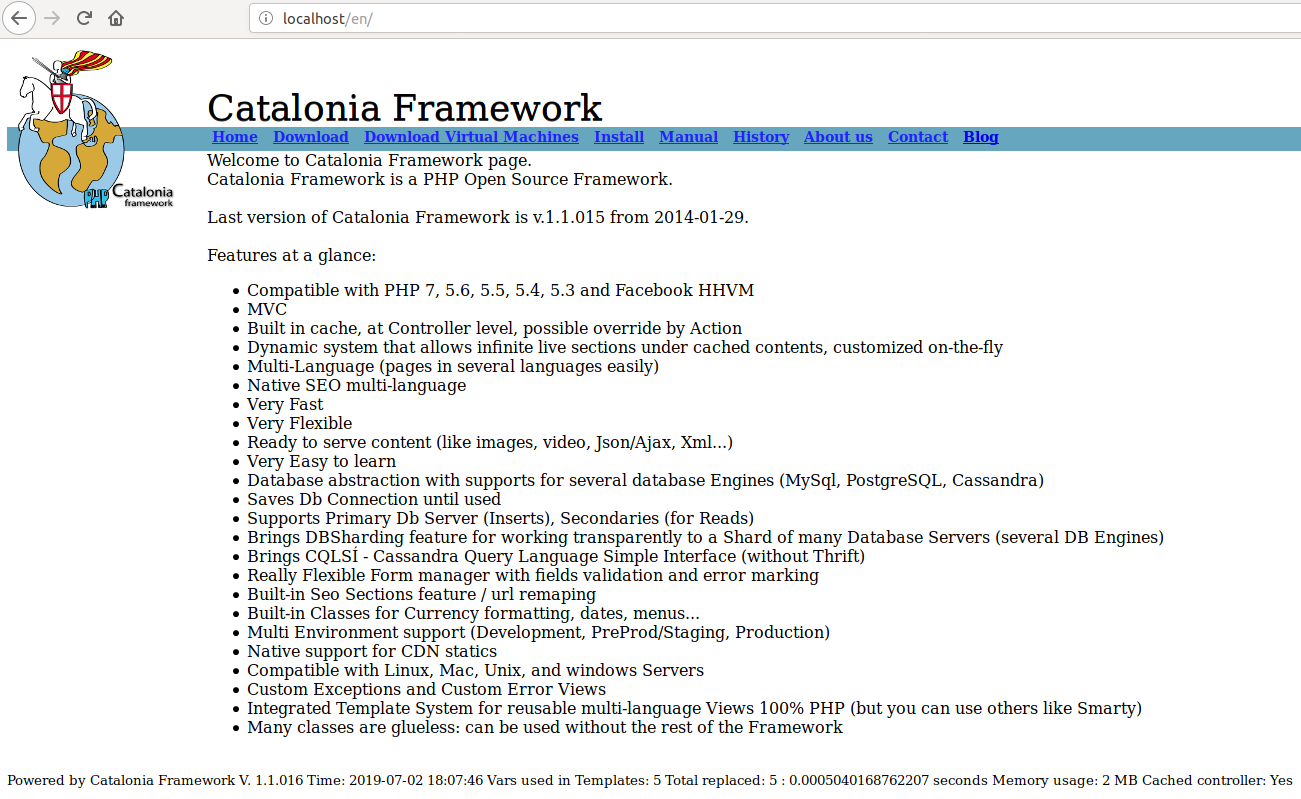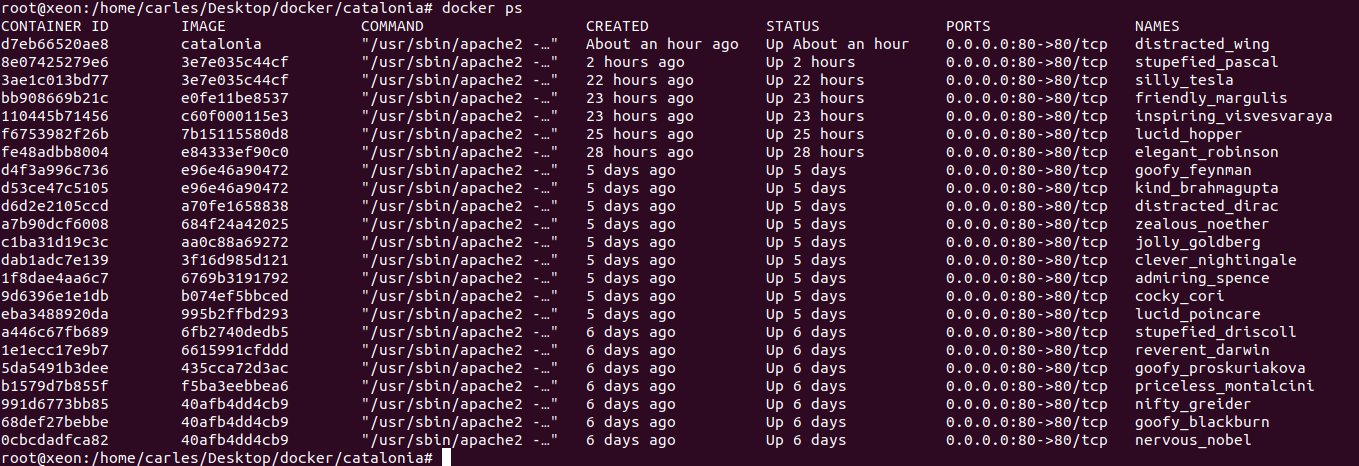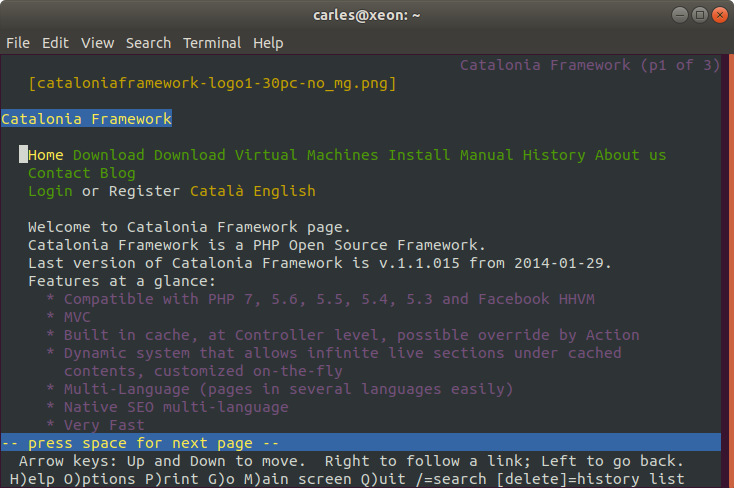Adding my Server as Docker, with PHP Catalonia Framework, explained

Update: 2021-07-23 Ubuntu 19.04 is no longer available, so I updated the article in order to work with Ubuntu 20.04. and with PHP 7.4 and all their dependencies.
The previous day I explained how I migrated my old Server (Amazon Instance) to a more powerful model, with more recent OS, WebServer, etc…
This was interesting under the point of view of dealing with elastic Ip’s, Amazon AWS Volumes, etc… but was a process basically manual. I could have generated an immutable image to start from next time, but this is another discussion, specially because that Server Instance has different base Software, including a MySql Database.
This time I want to explain, step by step, how to containerize my Server, so I can port to different platforms, and I can be independent on what the Server Operating System is. It will work always, as we defined the Operating System for the Docker Container.
So we start to use IaC (Infrastructure as Code).
So first you need to install docker.
So basically if your laptop is an Ubuntu 18.04 LTS or 20.04 LTS you have to:
sudo apt install docker.io
Start and Automate Docker
The Docker service needs to be setup to run at startup. To do so, type in each command followed by enter:
sudo systemctl start docker
sudo systemctl enable docker
Create the Dockerfile
For doing this you can use any text editor, but as we are working with IaC why not use a Code Editor?.
You can use the versatile PyCharm, that has modules for understanding Docker and so you can use Control Version like git too.

This is the updated Dockerfile to work with Ubuntu 20.04 LTS
FROM ubuntu:20.04
MAINTAINER Carles <carles@carlesmateo.com>
ARG DEBIAN_FRONTEND=noninteractive
#RUN echo "nameserver 8.8.8.8" > /etc/resolv.conf
RUN echo "Europe/Ireland" | tee /etc/timezone
# Note: You should install everything in a single line concatenated with
# && and finalizing with
# apt autoremove && apt clean
# In order to use the less space possible, as every command is a layer
RUN apt update && apt install -y apache2 ntpdate libapache2-mod-php7.4 mysql-server php7.4-mysql php-dev libmcrypt-dev php-pear git && apt autoremove && apt clean
RUN a2enmod rewrite
RUN mkdir -p /www
# In order to activate Debug
# RUN sed -i "s/display_errors = Off/display_errors = On/" /etc/php/7.2/apache2/php.ini
# RUN sed -i "s/error_reporting = E_ALL & ~E_DEPRECATED & ~E_STRICT/error_reporting = E_ALL/" /etc/php/7.2/apache2/php.ini
# RUN sed -i "s/display_startup_errors = Off/display_startup_errors = On/" /etc/php/7.2/apache2/php.ini
# To Debug remember to change:
# config/{production.php|preproduction.php|devel.php|docker.php}
# in order to avoid Error Reporting being set to 0.
ENV PATH_CATALONIA /www/www.cataloniaframework.com/
ENV PATH_CATALONIA_WWW /www/www.cataloniaframework.com/www/
ENV PATH_CATALONIA_CACHE /www/www.cataloniaframework.com/cache/
ENV APACHE_RUN_USER www-data
ENV APACHE_RUN_GROUP www-data
ENV APACHE_LOG_DIR /var/log/apache2
ENV APACHE_PID_FILE /var/run/apache2/apache2.pid
ENV APACHE_RUN_DIR /var/run/apache2
ENV APACHE_LOCK_DIR /var/lock/apache2
ENV APACHE_LOG_DIR /var/log/apache2
RUN mkdir -p $APACHE_RUN_DIR
RUN mkdir -p $APACHE_LOCK_DIR
RUN mkdir -p $APACHE_LOG_DIR
RUN mkdir -p $PATH_CATALONIA
RUN mkdir -p $PATH_CATALONIA_WWW
RUN mkdir -p $PATH_CATALONIA_CACHE
# Remove the default Server
RUN sed -i '/<Directory \/var\/www\/>/,/<\/Directory>/{/<\/Directory>/ s/.*/# var-www commented/; t; d}' /etc/apache2/apache2.conf
RUN rm /etc/apache2/sites-enabled/000-default.conf
COPY www.cataloniaframework.com.conf /etc/apache2/sites-available/
RUN chmod 777 $PATH_CATALONIA_CACHE
RUN chmod 777 $PATH_CATALONIA_CACHE.
RUN chown --recursive $APACHE_RUN_USER.$APACHE_RUN_GROUP $PATH_CATALONIA_CACHE
RUN ln -s /etc/apache2/sites-available/www.cataloniaframework.com.conf /etc/apache2/sites-enabled/
# Note: You should clone locally and COPY to the Docker Image
# Also you should add the .git directory to your .dockerignore file
# I made this way to show you and for simplicity, having everything
# in a single file
##RUN git clone https://github.com/cataloniaframework/cataloniaframework_v1_sample_website /www/www.cataloniaframework.com
##RUN git checkout tags/v.1.16-web-1.0
# In order to change profile to Production
# RUN sed -i "s/define('ENVIRONMENT', DOCKER)/define('ENVIRONMENT', PRODUCTION)/" /var/www/www.cataloniaframework.com/config/general.php
COPY *.php /www/www.cataloniaframework.com/www
# for debugging
#RUN apt-get install -y vim
RUN service apache2 restart
EXPOSE 80
CMD ["/usr/sbin/apache2", "-D", "FOREGROUND"]
The www.cataloniaframework.com.conf file
As you saw in the Dockerfile you have the line:
COPY www.cataloniaframework.com.conf /etc/apache2/sites-available/
This will copy the file www.cataloniaframework.com.conf that must be in the same directory that the Dockerfile file, to the /etc/apache2/sites-available/ folder in the container.
<VirtualHost *:80>ServerAdmin webmaster@cataloniaframework.com# Uncomment to use a DNS name in a multiple VirtualHost Environment#ServerName www.cataloniaframework.com#ServerAlias cataloniaframework.comDocumentRoot /www/www.cataloniaframework.com/www<Directory /www/www.cataloniaframework.com/www/>Options -Indexes +FollowSymLinks +MultiViewsAllowOverride AllOrder allow,denyallow from allRequire all granted</Directory>ErrorLog ${APACHE_LOG_DIR}/www-cataloniaframework-com-error.log# Possible values include: debug, info, notice, warn, error, crit,# alert, emerg.LogLevel warnCustomLog ${APACHE_LOG_DIR}/www-cataloniaframework-com-access.log combined</VirtualHost>
Stopping, starting the docker Service and creating the Catalonia image
service docker stop && service docker start
To build the Docker Image we will do:
docker build -t catalonia . --no-cache
I use the –no-cache so git is pulled and everything is reworked, not kept from cache.
Now we can run the Catalonia Docker, mapping the 80 port.
docker run -d -p 80:80 catalonia
If you want to check what’s going on inside the Docker, you’ll do:
docker ps

And so in this case, we will do:
docker exec -i -t distracted_wing /bin/bash
Finally I would like to check that the web page works, and I’ll use my preferred browser. In this case I will use lynx, the text browser, cause I don’t want Firefox to save things in the cache.

Rules for writing a Comment